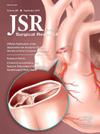术中吲哚菁绿血管造影用于立即乳房重建的灌注评估与减少再手术和恢复相关
IF 1.7
3区 医学
Q2 SURGERY
引用次数: 0
摘要
背景:即刻乳房再造术的并发症发生率高于延迟乳房再造术,部分原因在于乳房切除术皮瓣坏死的风险以及植入式和自体乳房再造术皮瓣灌注充足的风险。本研究在全国范围内分析了吲哚菁绿(ICG)对立即乳房重建患者30 d手术结果的影响。方法回顾性分析2005 - 2022年国家外科质量改进计划的数据集。采用多变量logistic回归来评估ICG血管造影对手术结果的影响。所有回归模型均表现出足够的拟合(均P <; 0.001)。结果在国家外科质量改进计划数据库中的11,574,114例患者中,11,201例患者接受了立即乳房重建,其中287例(2.6%)患者接受了术中ICG血管造影。ICG血管造影更常用于基于植入物的重建(13.7%对9.4%,P = 0.035)和美国麻醉医师学会III级以上的患者(37.3%对26.6%,P < 0.001)。多变量回归结果显示,术中应用ICG血管造影与术后再手术风险降低14.3倍(优势比0.07[95%可信区间0.01-0.51],P = 0.008)和4.8倍(优势比0.21[95%可信区间0.07-0.65],P = 0.007)相关。结论超声造影在乳房即刻重建中有一定的应用价值,尤其适用于美国麻醉学会分级较高的患者。外科医生可能更倾向于使用这种技术来评估乳房切除术皮瓣的质量,在立即种植重建而不是自体重建。本文章由计算机程序翻译,如有差异,请以英文原文为准。
Intraoperative Indocyanine Green Angiography Use for Perfusion Assessment in Immediate Breast Reconstruction Is Associated With Reduced Reoperation and Takeback
Background
Immediate breast reconstruction has higher rates of complications than delayed breast reconstruction, in part due to the risks of mastectomy flap necrosis and adequate flap perfusion in implant-based and autologous reconstruction. This study analyzes the impact of indocyanine green (ICG) on 30-d surgical outcomes among patients who underwent immediate breast reconstruction on a national scale.
Methods
A retrospective review was performed using the National Surgical Quality Improvement Program data sets from 2005 to 2022. Multivariable logistic regressions were performed to assess the impact of ICG angiography on surgical outcomes. All regression models demonstrated adequate fit (all P < 0.001).
Results
Among 11,574,114 patients in the National Surgical Quality Improvement Program database, 11,201 patients underwent immediate breast reconstruction, and 287 (2.6%) of whom underwent intraoperative ICG angiography. ICG angiography was more commonly used in implant-based versus autologous reconstruction (13.7% versus 9.4%, P = 0.035) and in patients with American Society of Anesthesiologists class III or higher (37.3% versus 26.6%, P < 0.001). Multivariable regressions determined that using intraoperative ICG angiography was associated with reduced risk of operation room takebacks by 14.3-fold (odds ratio 0.07 [95% confidence interval 0.01-0.51], P = 0.008) and 30-d reoperation by 4.8-fold (odds ratio 0.21 [95% confidence interval 0.07-0.65], P = 0.007).
Conclusions
ICG angiography may be useful in immediate breast reconstruction, especially for patients of higher American Society of Anesthesia class. Surgeons may be more inclined to use this technology to assess mastectomy flap quality in immediate implant-based reconstruction rather than autologous reconstruction.
求助全文
通过发布文献求助,成功后即可免费获取论文全文。
去求助
来源期刊
CiteScore
3.90
自引率
4.50%
发文量
627
审稿时长
138 days
期刊介绍:
The Journal of Surgical Research: Clinical and Laboratory Investigation publishes original articles concerned with clinical and laboratory investigations relevant to surgical practice and teaching. The journal emphasizes reports of clinical investigations or fundamental research bearing directly on surgical management that will be of general interest to a broad range of surgeons and surgical researchers. The articles presented need not have been the products of surgeons or of surgical laboratories.
The Journal of Surgical Research also features review articles and special articles relating to educational, research, or social issues of interest to the academic surgical community.

 求助内容:
求助内容: 应助结果提醒方式:
应助结果提醒方式:


